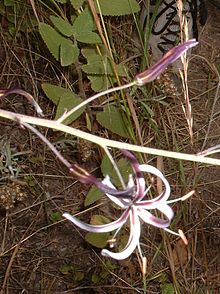Amole
|
Chlorogalum Soap plant, Amole |
|
|---|---|
 |
|
|
Chlorogalum pomeridianum Wavy-leafed Soap Plant |
|
| Scientific classification | |
| Kingdom: | Plantae |
| Clade: | Angiosperms |
| Clade: | Monocots |
| Order: | Asparagales |
| Family: | Asparagaceae |
| Subfamily: | Agavoideae |
| Genus: |
Chlorogalum (Lindl.) Kunth |
| Synonyms | |
|
|
The common names soap plant, soaproot and amole refer to the genus Chlorogalum. They are native to western North America, from Oregon to Baja California, and are mostly found in California. Common names of the genus and several species derive from their use as soap.
Soap plants are perennial plants, with more or less elongated bulbs, depending on the species. The bulbs can be white or brown, and in most species have a fibrous coat. The flowers are borne on a long central stem, and appear to have six separate petals (not all are petals in the technical sense). There are six stamens, which are prominent in most species.
The placement of the genus Chlorogalum has varied considerably. In the APG III system, followed here, it is placed in the family Asparagaceae, subfamily Agavoideae, based on molecular systematics evidence. The second edition of the Jepson Manual places the genus in Agavaceae (equivalent to the APG III subfamily Agavoideae). Until the 1980s, the genus was generally treated in the Lily family, Liliaceae, in the order Liliales, e.g. the Flora of North America, published in 1993 onwards, has Chlorogalum in Liliaceae. The genus has also been placed in its own family, Chorogalaceae, or in a group within the hyacinth family Hyacinthaceae (now Scilloideae), in the order Asparagales. Phylogenetic studies based on molecular evidence (e.g. Pfosser and Speta 1999), suggested that, along with Camassia, Chlorogalum seemed to be most closely related to Agave and Anthericum.
...
Wikipedia
